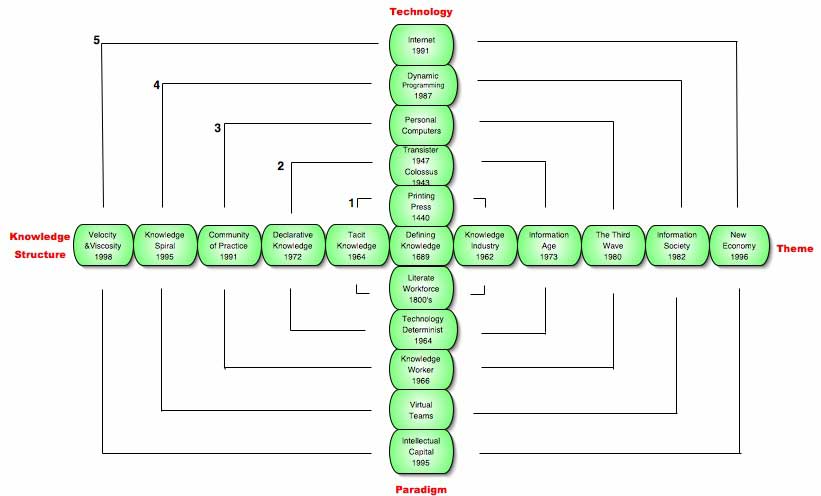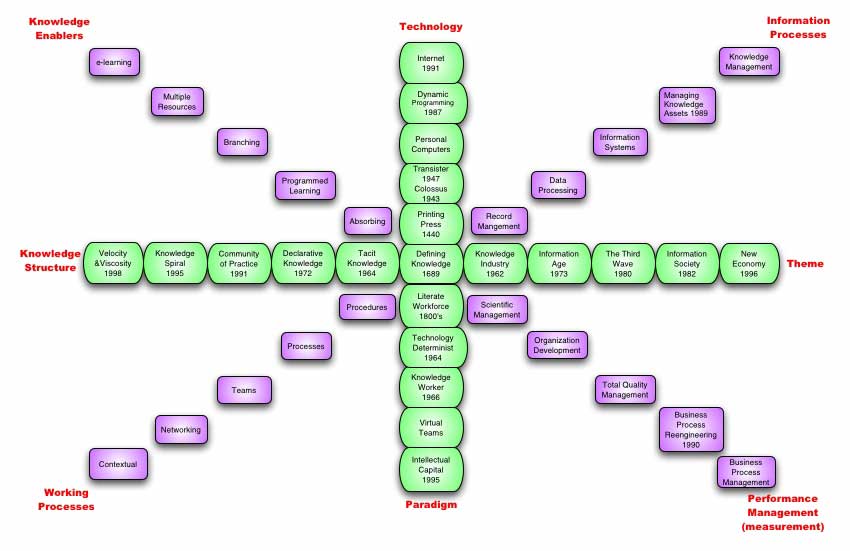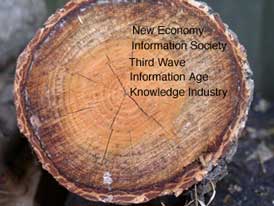Note: This site is moving to KnowledgeJump.com. Please reset your bookmark.
Knowledge History Graph
The history of knowledge can be divided into four categories:
- Technology
- Era
- Paradigm
- Knowledge Structure
The categories are laid out using both vertical and horizontal axes so that it forms a +, with Defining Knowledge being the center of the +, notice there are five boxes, which are called “Themes”:

Each intersection has an associated process or concept to form the x (purple boxes):

Click on any section of the above map to learn more about it
The Five Themes of Knowledge Management Framework
 This mapping process of the history of knowledge provides a framework of the five major themes about our conceptual understanding of knowledge. Note that each theme does not replace the prior ones, but rather builds on them — similar to the growth rings within a tree. Thus, just as a tree builds upon itself, so does the history of knowledge management.
This mapping process of the history of knowledge provides a framework of the five major themes about our conceptual understanding of knowledge. Note that each theme does not replace the prior ones, but rather builds on them — similar to the growth rings within a tree. Thus, just as a tree builds upon itself, so does the history of knowledge management.
You can view the various themes and ideas by clicking on the corresponding parts of the above concept map, or you can follow the article below and click on the various links. Note that there are a few concepts and themes that do NOT have a corresponding link on the map above or the story below.
Theme 1 - The Knowledge Industry is Born - 1960s
Machlup realizes that knowledge is starting to become a commodity and coins the term knowledge industry. The reason this is made possible is due to a technology invented over five centuries ago — the printing press. Although it took some time, this technology was responsible for creating a literate workforce through the means of absorption.
This increase in worker literacy also helped to spur on the industry revolution by allowing more elaborate procedures to be put in place. Some of these procedures require more than simply absorbing some information in order to be able to perform; they require skills. And some of these skills were not easily taught to others for they require tacit knowledge.
With more complex procedures put into place, the amount of paperwork increases, which requires more record management. Thus, with a lot of new processes being applied to the work place and a slew of records to track such processes, it did not take long before the technique of scientific management was born to help organize and make it more efficient.
Theme 2 - Information Age - 1973
In Bell's Information Age (or information society), the major commodity becomes information. Along with Bell, McLuhan writes about the information age and how we are not only shaping technology, but in turn, technology is shaping us.
During this period, two great technologies of the 20th century are invented — the computer and the transistor. The computer is able to manipulate great quantities of data, thus helping us to transform that data into meaningful information; while the transistor starts the revolution of transforming large, bulky, and expensive computers (which were really more like calculators) into small and inexpensive calculating machines and next, into desktop computers for the masses.
In 1890, Herman Hollerith compiled the U.S. Census statistics by passing punch cards over electrical contacts. This, coupled with our obsession for information helps to transform record keeping into an art and knowledge profession — data processing.
Theories on knowledge were expanded to include not only procedural knowledge, but also declarative knowledge. Skinner brought us the concept of programmed learning, which is one of the primary methods for Computer Based Training and much of the training that can now delivered via the web. In addition, programmed learning is the forerunner of simulations.
Taylor's Scientific Management failed to account for the human element of performance improvement, thus another movement is developed to help us improve all these new technologies and processes — Organizational Development. Unlike Scientific Management, OD not only focuses on the processes within an organization, but also the people.
Theme 3 - The Third Wave - 1980
Toffler's book, The Third Wave, took information to the next level — not only is information an important part of our society, but we are also becoming an information civilization. Part of the reason that Toffler's book makes such a huge impact on its readers is that the personal computer arrived to market just a couple of years before the book's release, thus people were not only able to use this technology at work, but also in their homes. The most important of these were the Apple computer, and it was not really the computer itself that people wanted, but rather one program — Dan Bricklin & Bob Frankston's VisiCalc Spreadsheet Software. This was a powerful piece of software that allowed the average user to make advanced what-if calculations in a fraction of the time that it previously took using paper and pencil.
Shortly after personal computers arrive on the scene they were viewed as a viable method for instruction. And the instructional method used most was Norman Crowder's branching style of programming that was developed in 1958.
During this time frame, the human element is also taken to the next level, first by Drucker's Knowledge Worker and next by Jean Lave and Etienne Wenger's Community of Practice (CoP). Drucker's term is quite important, for in the past, it was generally the upper-professionals, such as doctors, lawyers, and architectures that were the knowledge workers. Drucker expands this to acknowledge an army of workers that are starting to make a living with information, rather than materials. And one class are the workers that are combining information and computers in the organization to form information systems.
This combination of knowledge workers and CoPs gels the concept of teams — connect knowledge workers to other knowledge workers and the possibility of creative thinking and innovation expands.
Deming helps Japan to rebuild after WWII and takes performance/process improvement to an entirely new level with Total Quality Management. It is not until Japan becomes an economic power that the rest of the world starts looking at TQM.
Theme 4 - Information Society - 1962
John Naisbitt & Patricia Aburdene write that one of the trends of this century is our moving from an industrial society to an Information Society. Thus, the effect of new technologies that impact data/information/knowledge are not only felt in the work place, but also in society as a whole.
As we learn more about the concept of learning and the knowledge creation process of Spirals, we realize that it is not a linear process, but rather a quite dynamic one that involves Multiple Resources (blended Learning). This dynamic process is also carried over to programming, starting with Hypercard or dynamic programs.
But information does not just move via technology, it also requires a network of people. And coordinating the efforts of people and technology requiring new processes, or Business Process Reengineering.
This process of dynamic inter-connectivity carries over to the way we work. Although the internet as we know it has not yet been born, its seeds have been sown with such services as AOL and Prodigy and connectivity processes such as email. Teams are now able to bridge the distance gap through the concept of Virtual Teams.
Organizations start to understand the dynamic way in which we work and learn and soon realize that business is not just about managing commodities, but also about Managing Knowledge Assets.
Theme - 5 - Twelve Themes of the New Economy
Don Tapscott writes how the digital and knowledge networks are the highways for our economy in Twelve Themes of the New Economy. Karl-Erik Sveiby pushes the concept of Managing Knowledge Assets to the next level by conceptualizing a means for measuring Intellectual Capital.
As the Internet grows and allows us to push information even faster, Davenport and Prusak realize there are two dimensions to being able to understand all this information coming at us — Velocity and Viscosity. Thus, elearning must become more that a content dump, it must allow for rich experiences or context.
As organizations realize the importance of knowledge, they try to manage it; first by trying to capture it with elaborate data programs, which mostly fail; for knowledge is within people, rather than machines. To help with the management of all this, process management takes another jump with BMP.
Next Step
Return to the Information and Knowledge history page

